Abstract
The use of THAM in the treatment of neonatal acidaemia is surveyed over a 3-year period. Of 100 babies to whom the drug was given while they were breathing spontaneously, 17% had respiratory depression during, or within two minutes of injection. If only potentially viable babies are considered, the incidence of respiratory depression increases to 20% and the incidence in babies with respiratory distress is 17%. No single group of babies was particularly susceptible to this action of THAM, except those who had had a previous spontaneous apnoeic attack. No babies became apnoeic after the injection of sodium bicarbonate. It appears that in the 'good prognosis' group according to the hyperoxia test those babies who require correction of their pH have a higher death rate than those who do not. There was no statistically significant increase in the death rate of babies who deteriorated after THAM, but several of these babies only survived after treatment with artificial ventilation. There was an increased incidence of intraventricular haemorrhage in those babies who received 7% THAM rather than 3·60% THAM, but this may be due to other factors in their illness.
Full text
PDF
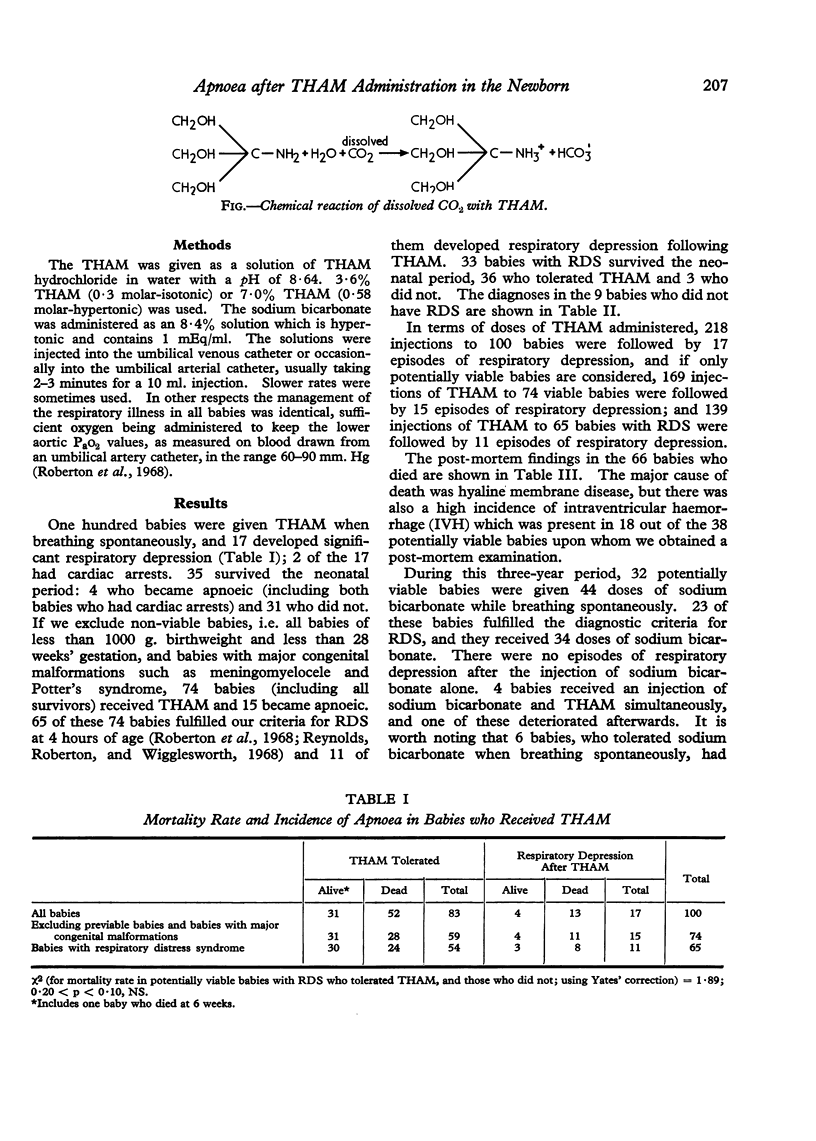
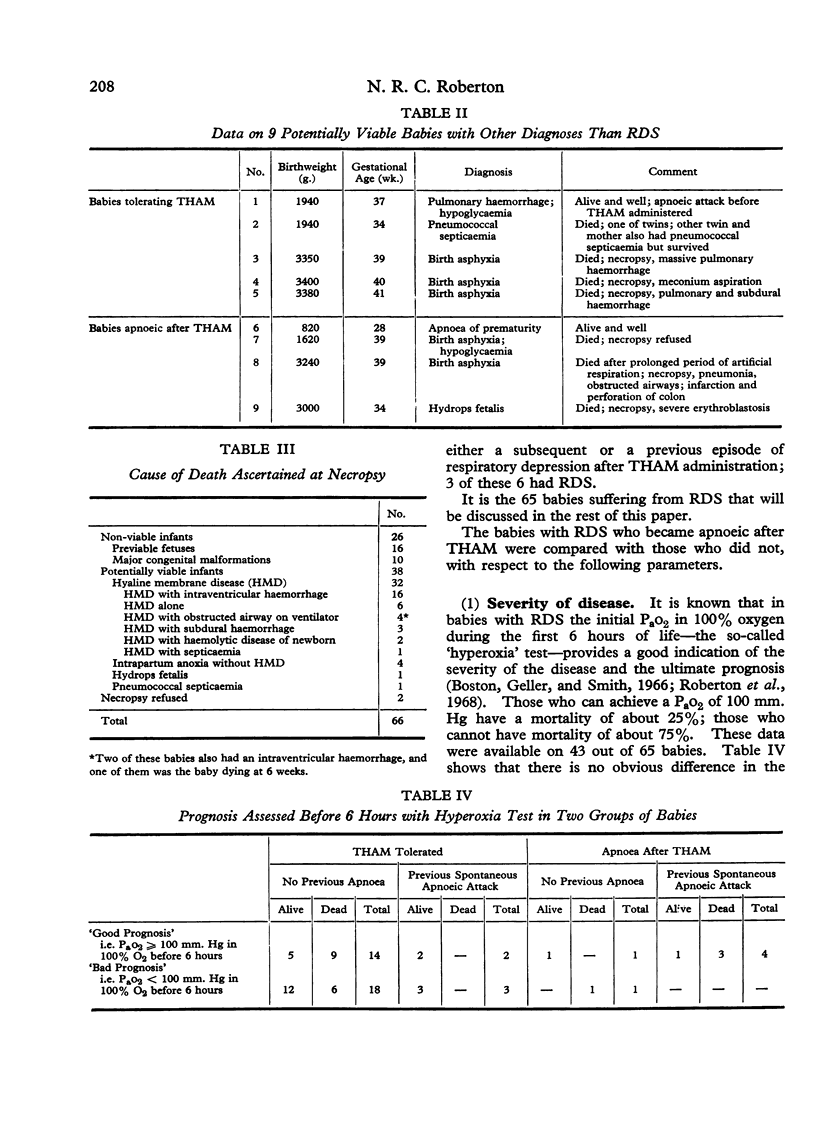
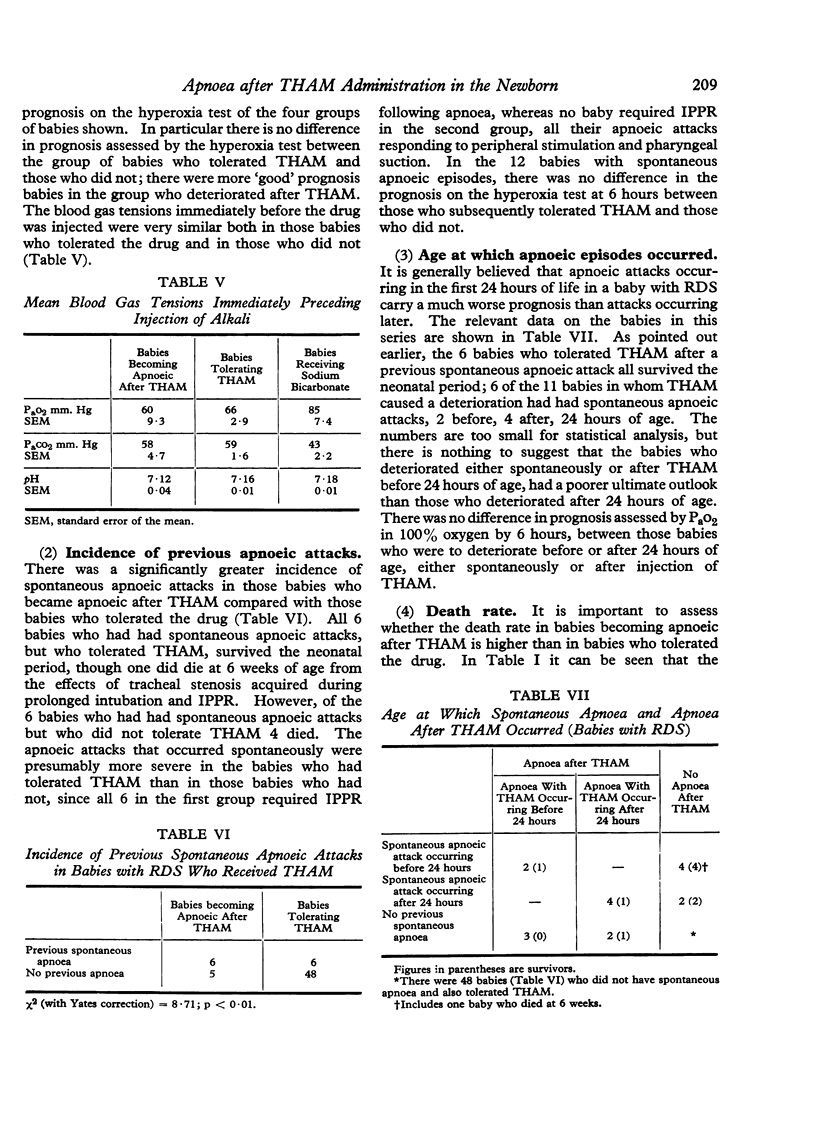
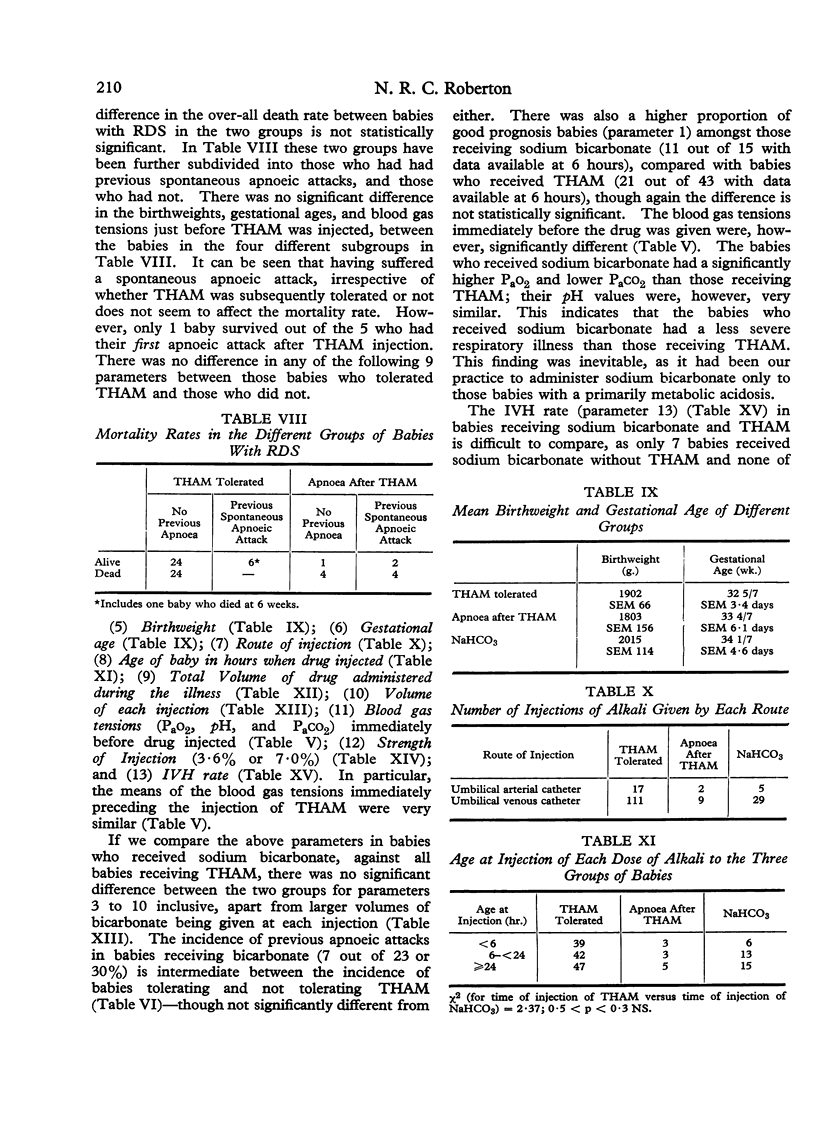
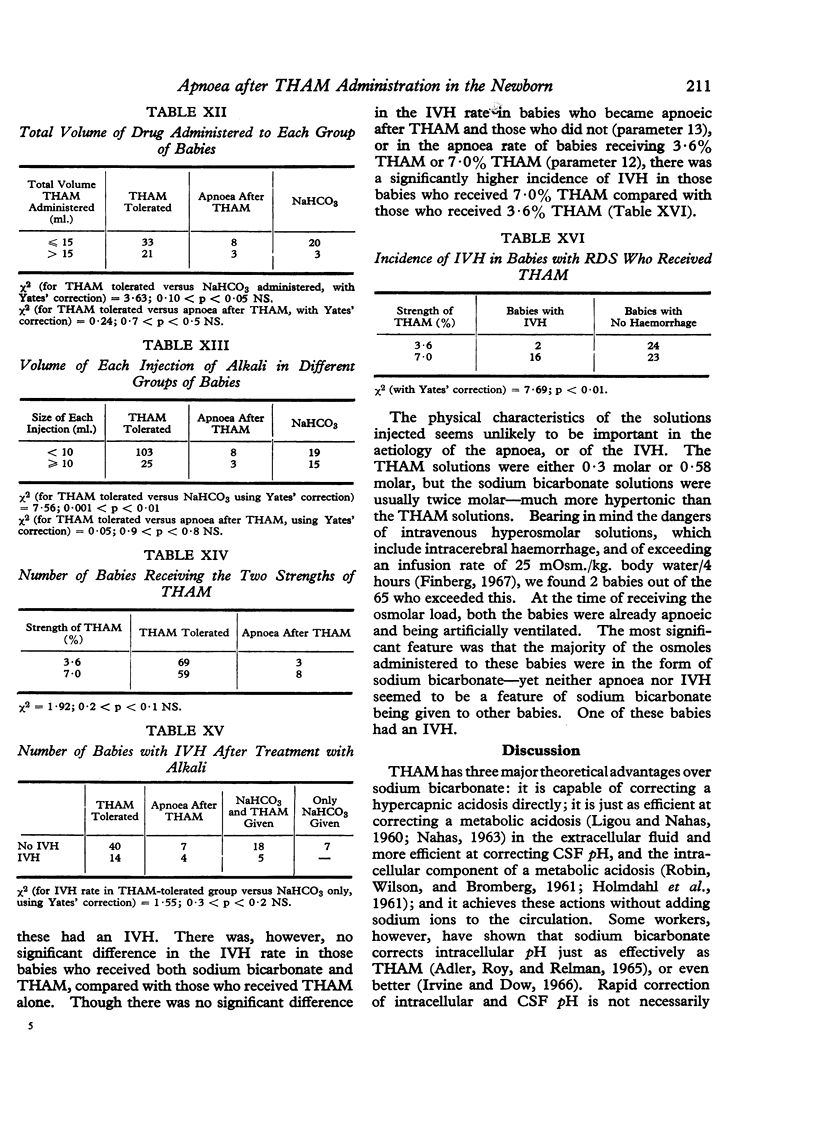
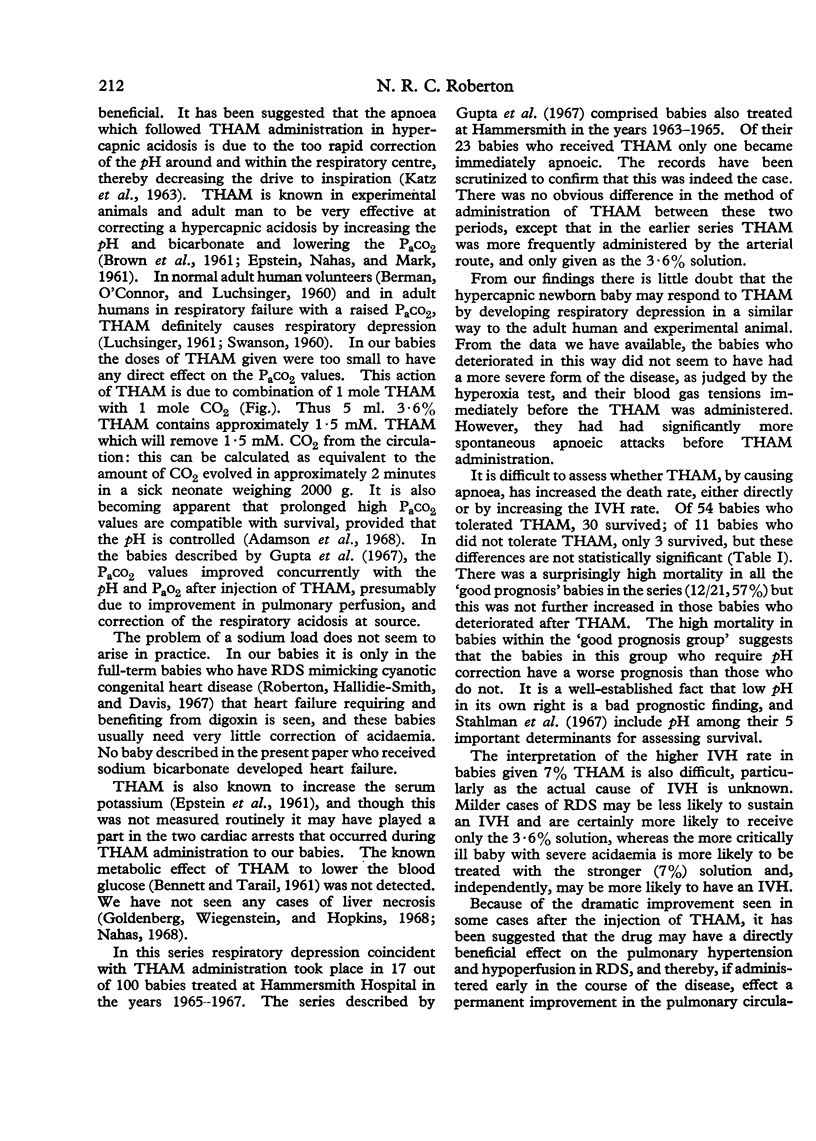
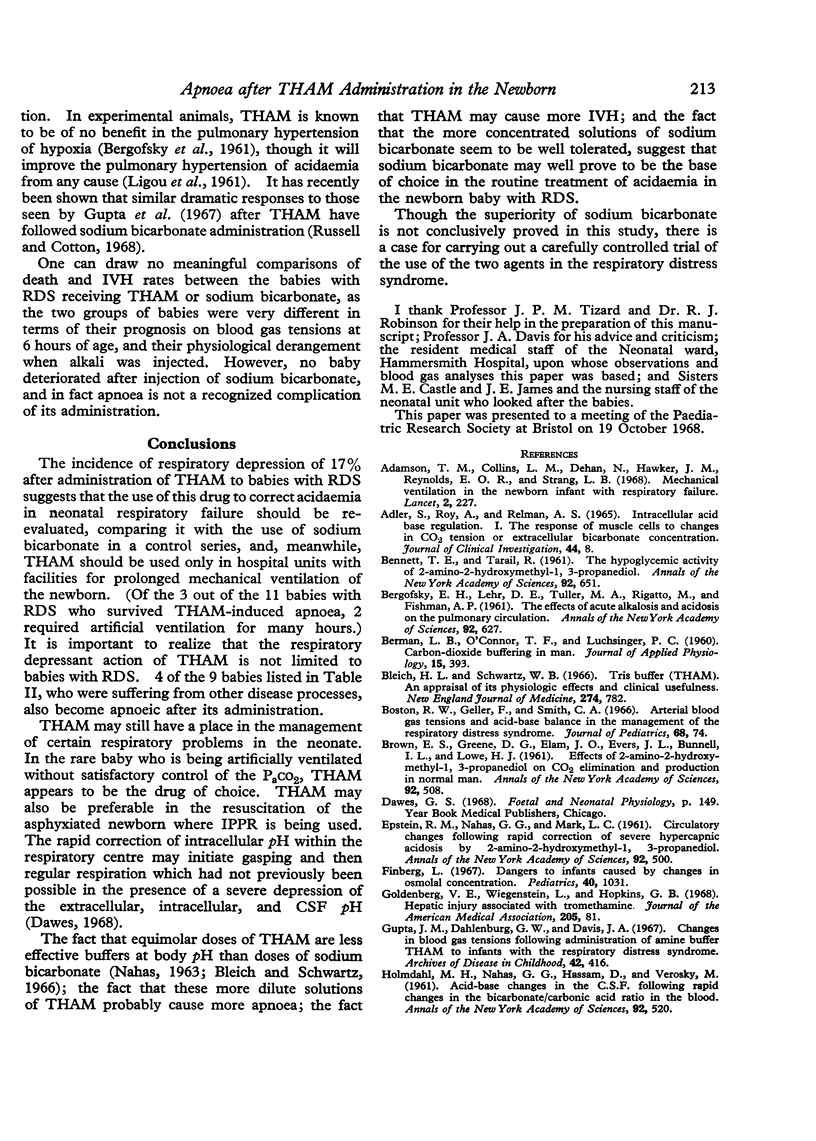
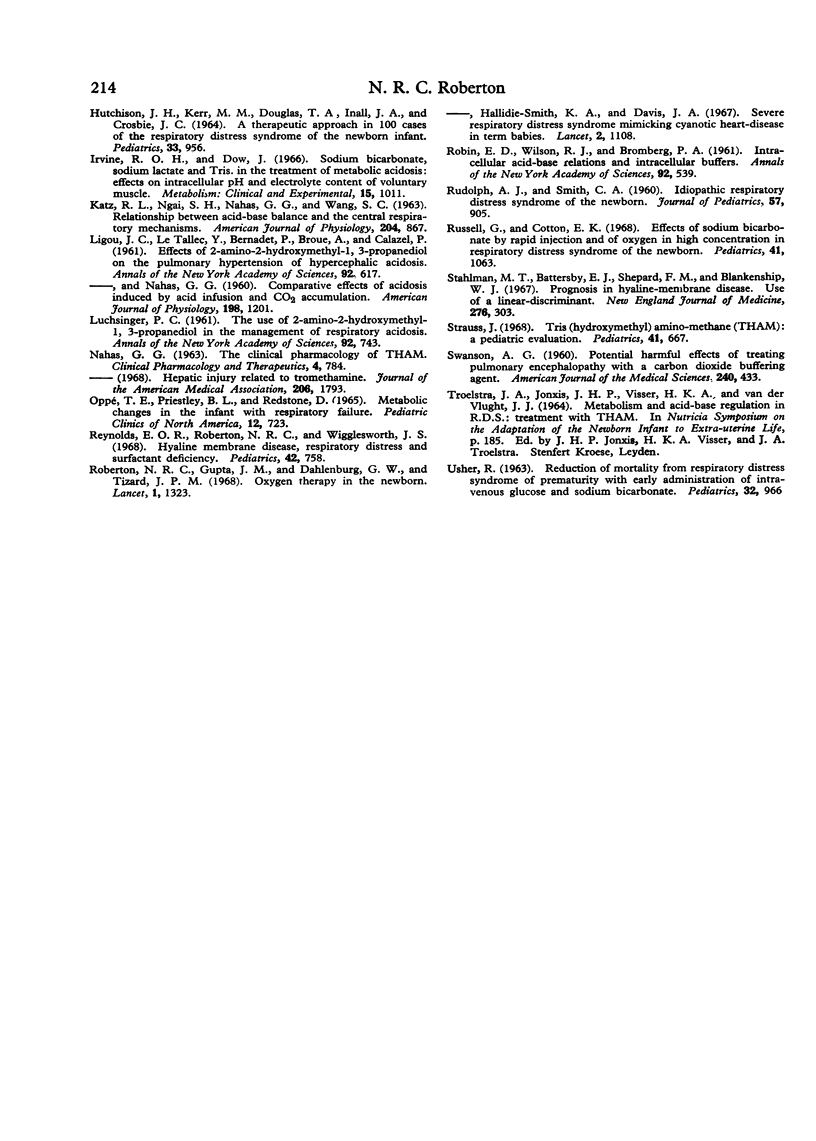
Selected References
These references are in PubMed. This may not be the complete list of references from this article.
- ADLER S., ROY A., RELMAN A. S. INTRACELLULAR ACID-BASE REGULATION. I. THE RESPONSE OF MUSCLE CELLS TO CHANGES IN CO2 TENSION OR EXTRACELLULAR BICARBONATE CONCENTRATION. J Clin Invest. 1965 Jan;44:8–20. doi: 10.1172/JCI105129. [DOI] [PMC free article] [PubMed] [Google Scholar]
- Adamson T. M., Collins L. M., Dehan M., Hawker J. M., Reynolds E. O., Strang L. B. Mechanical ventilation in newborn infants with respiratory railure. Lancet. 1968 Aug 3;2(7562):227–231. doi: 10.1016/s0140-6736(68)92348-9. [DOI] [PubMed] [Google Scholar]
- BERMAN L. B., O'CONNOR T. F., LUCHSINGER P. C. Carbon dioxide buffering in man. J Appl Physiol. 1960 May;15:393–396. doi: 10.1152/jappl.1960.15.3.393. [DOI] [PubMed] [Google Scholar]
- Bleich H. L., Schwartz W. B. Tris buffer (THAM). An appraisal of its physiologic effects and clinical usefulness. N Engl J Med. 1966 Apr 7;274(14):782–787. doi: 10.1056/NEJM196604072741407. [DOI] [PubMed] [Google Scholar]
- Boston R. W., Geller F., Smith C. A. Arterial blood gas tensions and acid-base balance in the management of the respiratory distress syndrome. J Pediatr. 1966 Jan;68(1):74–89. doi: 10.1016/s0022-3476(66)80424-9. [DOI] [PubMed] [Google Scholar]
- EPSTEIN R. M., NAHAS G. G., MARK L. C. Circulatory changes following rapid correction of severe hypercapnic acidosis by 2-amino-2-hydroxymethyl-1,3-propanediol. Ann N Y Acad Sci. 1961 Jun 17;92:500–507. doi: 10.1111/j.1749-6632.1961.tb45000.x. [DOI] [PubMed] [Google Scholar]
- Finberg L. Dangers to infants caused by changes in osmolal concentration. Pediatrics. 1967 Dec;40(6):1031–1034. [PubMed] [Google Scholar]
- Goldenberg V. E., Wiegenstein L., Hopkins G. B. Hepatic injury associated with tromethamine. JAMA. 1968 Jul 8;205(2):81–84. [PubMed] [Google Scholar]
- Gupta J. M., Dahlenburg G. W., Davis J. A. Changes in blood gas tensions following administration of amine buffer THAM to infants with respiratory distress syndrome. Arch Dis Child. 1967 Aug;42(224):416–427. doi: 10.1136/adc.42.224.416. [DOI] [PMC free article] [PubMed] [Google Scholar]
- HOLMDAHL M. H., NAHAS G. G., HASSAM D., VEROSKY M. Acidbase changes in the cerebrospinal fluid following rapid changes in the bicarbonate/carbonic acid ratio in the blood. Ann N Y Acad Sci. 1961 Jun 17;92:520–527. doi: 10.1111/j.1749-6632.1961.tb45002.x. [DOI] [PubMed] [Google Scholar]
- HUTCHISON J. H., KERR M. M., DOUGLAS T. A., INALL J. A., CROSBIE J. C. A THERAPEUTIC APPROACH IN 100 CASES OF THE RESPIRATORY DISTRESS SYNDROME OF THE NEWBORN INFANT. Pediatrics. 1964 Jun;33:956–964. [PubMed] [Google Scholar]
- Irvine R. O., Dow J. Sodium bicarbonate, sodium lactate and Tris in the treatment of metabolic acidosis: effects on intracellular pH and electrolyte content of voluntary muscle. Metabolism. 1966 Nov;15(11):1011–1019. doi: 10.1016/0026-0495(66)90049-7. [DOI] [PubMed] [Google Scholar]
- KATZ R. L., NGAI S. H., NAHAS G. G., WANG S. C. Relationship between acid-base balance and the central respiratory mechanisms. Am J Physiol. 1963 May;204:867–872. doi: 10.1152/ajplegacy.1963.204.5.867. [DOI] [PubMed] [Google Scholar]
- LIGOU J. C., LE TALLEC Y., BERNADET P., BROUE A., CALAZEL P. Effects of 2-amino-2-hydroxymethyl-1, 3-propanediol on the pulmonary hypertension of hypercapnic acidosis. Ann N Y Acad Sci. 1961 Jun 17;92:617–626. doi: 10.1111/j.1749-6632.1961.tb45010.x. [DOI] [PubMed] [Google Scholar]
- LIGOU J. C., NAHAS G. G. Comparative effects of acidosis induced by acid infusion and carbon dioxide accumulation. Am J Physiol. 1960 Jun;198:1201–1206. doi: 10.1152/ajplegacy.1960.198.6.1201. [DOI] [PubMed] [Google Scholar]
- LUCHSINGER P. C. The use of 2-amino-2-hydroxymethyl-1,3-propanediol in the management of respiratory acidosis. Ann N Y Acad Sci. 1961 Jun 17;92:743–750. doi: 10.1111/j.1749-6632.1961.tb45023.x. [DOI] [PubMed] [Google Scholar]
- NAHAS G. G. THE CLINICAL PHARMACOLOGY OF THAM (TRIS(HYDROXYMETHYL)AMINOMETHANE). Clin Pharmacol Ther. 1963 Nov-Dec;4:784–803. doi: 10.1002/cpt196346784. [DOI] [PubMed] [Google Scholar]
- ROBIN E. D., WILSON R. J., BROMBERG P. A. Intracellular acidbase relations and intracellular buffers. Ann N Y Acad Sci. 1961 Jun 17;92:539–546. doi: 10.1111/j.1749-6632.1961.tb45004.x. [DOI] [PubMed] [Google Scholar]
- Reynolds E. O., Roberton N. R., Wigglesworth J. S. Hyaline membrane disease, respiratory distress, and surfactant deficiency. Pediatrics. 1968 Nov;42(5):758–768. [PubMed] [Google Scholar]
- Roberton N. R., Gupta J. M., Dahlenburg G. W., Tizard J. P. Oxygen therapy in the newborn. Lancet. 1968 Jun 22;1(7556):1323–1329. doi: 10.1016/s0140-6736(68)92033-3. [DOI] [PubMed] [Google Scholar]
- Roberton N. R., Hallidie-Smith K. A., Davis J. A. Severe respiratory distress syndrome mimicking cyanotic heart-disease in term babies. Lancet. 1967 Nov 25;2(7526):1108–1110. doi: 10.1016/s0140-6736(67)90616-2. [DOI] [PubMed] [Google Scholar]
- Russell G., Cotton E. K. Effects of sodium bicarbonate by rapid injection and of oxygen in high concentration in respiratory distress syndrome of the newborn. Pediatrics. 1968 Jun;41(6):1063–1073. [PubMed] [Google Scholar]
- SWANSON A. G. Potential harmful effects of treating pulmonary encephalopathy with a carbon dioxide buffering agent. Am J Med Sci. 1960 Oct;240:433–437. doi: 10.1097/00000441-196010000-00004. [DOI] [PubMed] [Google Scholar]
- Stahlman M. T., Battersby E. J., Shepard F. M., Blankenship W. J. Prognosis in hyaline-membrane disease. Use of a linear-discriminant. N Engl J Med. 1967 Feb 9;276(6):303–309. doi: 10.1056/NEJM196702092760601. [DOI] [PubMed] [Google Scholar]
- Strauss J. Tris (hydroxymethyl) amino-methane (Tham): a pediatric evaluation. Pediatrics. 1968 Mar;41(3):667–689. [PubMed] [Google Scholar]
- USHER R. REDUCTION OF MORTALITY FROM RESPIRATORY DISTRESS SYNDROME OF PREMATURITY WITH EARLY ADMINISTRATION OF INTRAVENOUS GLUCOSE AND SODIUM BICARBONATE. Pediatrics. 1963 Dec;32:966–975. [PubMed] [Google Scholar]


